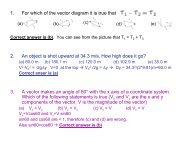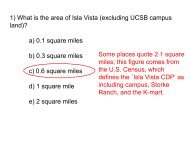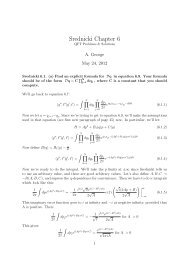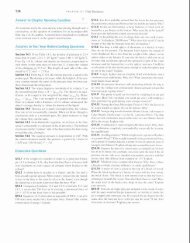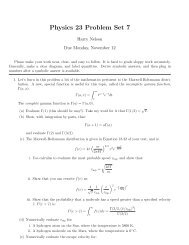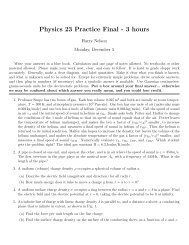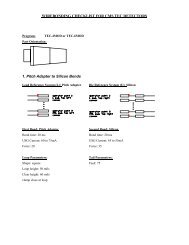Chapter 4 - UCSB HEP
Chapter 4 - UCSB HEP
Chapter 4 - UCSB HEP
Create successful ePaper yourself
Turn your PDF publications into a flip-book with our unique Google optimized e-Paper software.
WORK AND ENERGY<br />
Example 4.8<br />
Work Pone by a Central Force<br />
A central force is a radial force which depends only on the distance from<br />
dr=dri+rd@t) the origin. Let us find the work done by the central force F = f(r)F on<br />
\ a particle which moves from r, to rb. For simplicity we shall consider<br />
- f F=fIr)i motion in a wlane. for which dr = dr + r dB 6. Then<br />
= f 'f(r)i. (dr i 4- T dB 6)<br />
a<br />
The work is given by a simple one dimensional integral over the variable<br />
T. Since 8 has disappeared from the problem, it should be obvious that<br />
the work depends only on the initial and final radial distances [and, of<br />
course, on the particular form of f(r)], not on the particular path.<br />
For some forces, the work is different for different paths<br />
between the initial and final points. One familiar example is<br />
work done by the force of sliding friction. Here the force always<br />
opposes the motion, so that the work done by friction in moving<br />
through distance dS is dW = -f dS, where f is the magnitude<br />
of the frEction force. If we assume that f is constant, then the<br />
work done by friction in going from r, to rb along some path is<br />
where S is the total length of the path. The work is negative<br />
because the force always retards the particle. Wa, is never<br />
smaller in magnitude than fSo, where So is the distance between<br />
the two points, but by choosing a sufficiently devious route, 8 can<br />
be made arbitrarily large.<br />
(QJI<br />
Example 4.9<br />
A Path-dependent Line Integral<br />
Here is a second example of a path-dependent line integral. Let<br />
F = A(q0 -j- p2j), and consider the integral from (0,O) to (O,I), first<br />
1 c along path 1 and then along path 2, as shown in the figure. The force<br />
------- I(1,l)<br />
I<br />
1<br />
F has no physical significance, but the example illustrates the properties<br />
I.<br />
I<br />
of nonconservative forces. Since the segments of each path lie along a<br />
coordinate axis, it is particularly simple to evaluate the integrals. For<br />
I 1 : b<br />
1 I<br />
path 1 we have



